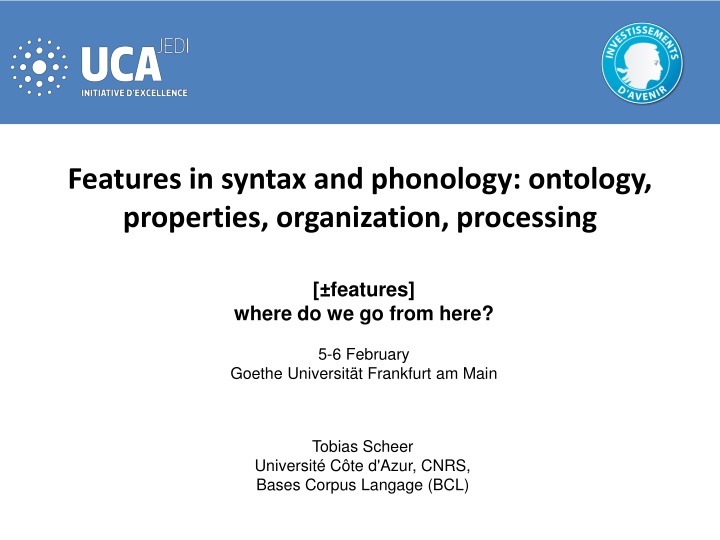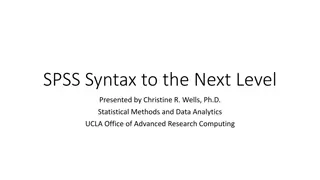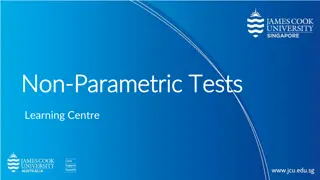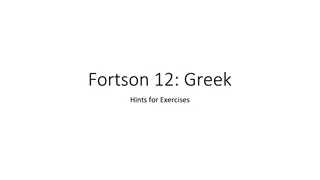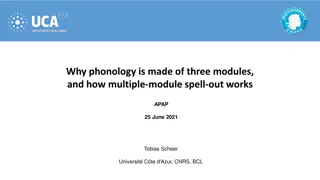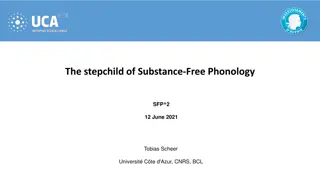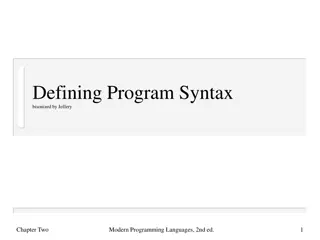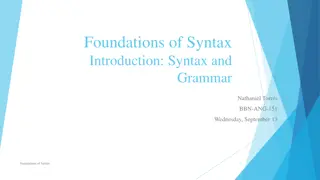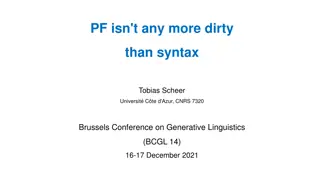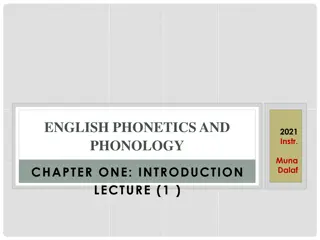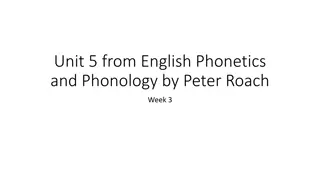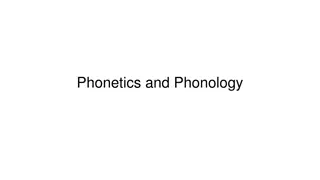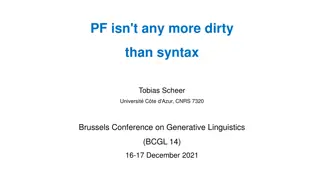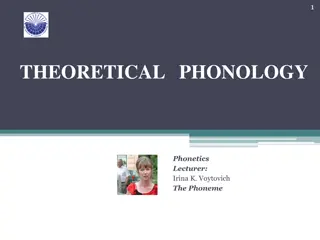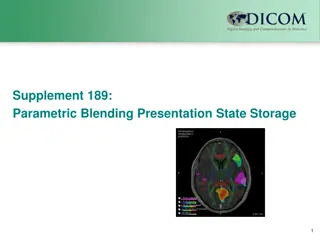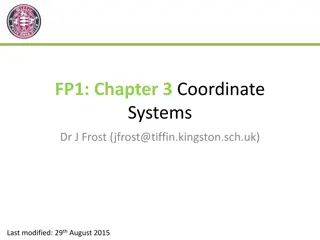Parametric Information in Syntax and Phonology: Features, Organization, Processing
Role of parametric information in syntax and phonology, focusing on features such as tense, aspect, and vocabulary distinctions. Delve into how parametric information impacts computation and language acquisition, distinguishing between merge-created hierarchies and lattices.
Download Presentation

Please find below an Image/Link to download the presentation.
The content on the website is provided AS IS for your information and personal use only. It may not be sold, licensed, or shared on other websites without obtaining consent from the author.If you encounter any issues during the download, it is possible that the publisher has removed the file from their server.
You are allowed to download the files provided on this website for personal or commercial use, subject to the condition that they are used lawfully. All files are the property of their respective owners.
The content on the website is provided AS IS for your information and personal use only. It may not be sold, licensed, or shared on other websites without obtaining consent from the author.
E N D
Presentation Transcript
Features in syntax and phonology: ontology, properties, organization, processing [ features] where do we go from here? 5-6 February Goethe Universit t Frankfurt am Main Tobias Scheer Universit C te d'Azur, CNRS, Bases Corpus Langage (BCL)
where is parametric information? Issue #1 Where is parametric information?
where is parametric information in syntax? Syntax: Merge-created vs. other hierarchies
where is parametric information in syntax? what we are talking about: a feature that is an argument of online computation (Merge): e.g. tense, v, aspect, etc. a feature that describes parametric information i.e. knowledge that a speaker gains about his/her language through L1- acquisition and which remains stable for a lifetime (save diachronic evolution). example: whether or not a language distinguishes animate / inanimate. how does parametric information impact actual computation? good question (see below) by excluding or making available certain vocabulary items for a numeration: in a language without animacy distinction the feature does not exist in the lexicon.
where is parametric information in syntax? feature describing parametric information yes yes yes feature used in online computation yes no no stored in long term memory member of a numeration loaded into working memory used in input-output computation acquired by the child hierarchy created yes no yes/no by Merge yes upon acquisition a tree a lattice trees and lattices have quite different formal properties: e.g. branchingness. represent different things: a sentence vs. cross-linguistic implicatures
where is parametric information in syntax? Lattices: hierarchies that are not Merge- created Harley & Ritter (2002: 486) Harbour (2016: 88)
where is parametric information in syntax? Where is parametric information? nanosyntax: idiosyncrasy of VIs all features are present in the tree (merge-created) classical: somewhere else there are also lattices Workings of nanosyntax question: is it the case that in nanosyntax ALL parametric information encoded in the fseq in its maximal shape (all languages have all case heads)? how does that work? all (person, case etc.) features are the input to a numeration in all languages. their hierarchy is universal: same f-seq in all languages language-specific patterns are due to the idiosyncrasy of Vocabulary Items. In case not all functional projections are distinct on the surface, VIs match only a span of them upon Spell-Out. example: in some languages GEN and DAT are spelt out together (same vocabulary item), while in others they spell out different vocabulary items.
where is parametric information in phonology? Phonology Where is parametric information?
where is parametric information in phonology? Parametric information in phonology: examples syllable structure segmental inventory stress contrast (more below) some languages have codas, others don't some languages have mid vowels e,o, others don't some languages have lexical stress, others don't same inventory, but different properties count no codas coda a Lattice: not an input or output or argument of phonological computation no internal coda internal coda no branching onset branching onset CVCV# CVCV# CVCVC# CVCV# CVCVC# CVC.CVC# CVCV# CVCVC# CVC.CVC# CCVC.CVC#
where is parametric information in phonology? the syllable lattice once acquired is stored in long-term memory has nothing to do with input-output computation (no input, argument, output) how does it impact phonological computation ? option 1: by restricting available vocabulary in the computation option 2: by well-formedness constraints on outputs
where is parametric information in phonology? option 1: restricting vocabulary suppose you need to syllabify VTRV and VRTV (T=obstruent, R=sonorant) in a language that allows for branching onsets (English), V.TRV and VR.TV are constructed because TR qualifies as a branching onset (rising sonority slope) while RT does not and this structure is available for the syllabification algorithm in a language without branching onsets (Semitic), the syllabification algorithm does not know what a branching onset is and hence syllabifies any VCCV as VC.CV (there is no evaluation of sonority slopes). encoding of the parametric difference identical computational systems working on distinct vocabulary difference in storage: certain vocabulary items are not stored (=available)
where is parametric information in phonology? option 2: constraints on the output (among others, OT) in a language that has branching onsets, the constraint NoBranchingOnset is low in the constraint hierarchy. in a language that has no branching onsets, NoBranchingOnset is high up in the constraint hierarchy. in both languages, candidates with branching onsets are created by the GEN function: V.TRV. but in the former they are filtered out by high-ranking NoBranchingOnset . In the latter they survive computation. encoding of the parametric difference distinct computational systems (different ranking). but no difference in the vocabulary available to the computation: all languages have the same constraint set and all syllable structures are generated by GEN. difference in storage: different constraint hierarchies are hard-wired and the result of acquisition
where is parametric information in phonology? context: a central mantra of OT there is only one locus where regularity (i.e. predictable patterns) is created: the constraint hierarchy. this concerns input-output computation definition of inventories systemic properties of inventories regularities that are found in the lexicon (Richness of the Base) non-phonological processes such as analogy (paradigm uniformity, Output-Output constraints) interfaces, i.e. communication with other modules (Align)
What about Feature Geometries? What about Feature Geometries that are used in phonology and syntax?
What about Feature Geometries? Feature Geometries are trees in phonology are lattices in syntax input and output of computation neither input nor output of computation Feature Geometry the whole point in phonology is to encode cross-linguistic generalizations regarding the behaviour of features in phonological processessing and implicatures in this realm in a representation.
What about Feature Geometries? /in-kredible/ [i -k]redible Clements & Hume (1995: 292) place assimilation n k
What about Feature Geometries? in phonology, feature geometries have never been used to encode language-specific parametric knowledge: the phonological feature geometry is universal (that's the ambition) it is stored in lexical items that are the input to computation it is modified by computation, and it is in its output it does not encode parametric knowledge of the speaker it is given at birth, rather then the result of acquisition
What about Feature Geometries? the use of Feature Geometry in phonology and syntax is entirely different. "look phonologists have advanced feature-technology, let's copy it" is ill- advised in the first place. the fact that feature geometry has an import in phonology does not mean anything in syntax: syntacticians using feature geometries cannot make an argument saying "this must be right since they do it in phonology, and it's about features on both sides." Feature Geometry did not need to destroy itself from within syntax (paper by Harbour-Elsholtz: Feature geometry: self-destructed)
Questions to be asked Feature Geometry is a specific means to graphically visualize dependencies among properties properties may be phonological, syntactic, related to football etc. properties may be computed or not encode parametric knowledge or not stored in long-term memory or not etc. feature geometries have no formal properties: they are the slaves of what they ambition to represent
Questions to be asked rather than asking what do we do with our features? maybe phonologists know? how can they be graphically represented? relevant questions are what is a syntactic feature? what are its formal properties? what's the labour it does in syntax? how do features interact, in a given language and cross-linguistically? Dependencies, implicatures. and especially what's the process at work when parametric knowledge is acquired? how and where is parametric knowledge stored? by which means does it bear on computation?
What are features? What are features? In phonology and syntax
What kind of prime? Features vs. Elements Issue #1: what kind of prime? Phonology: features vs. Elements [i] -high -low -back -round [e] I A -high -low -back +round [ ] +high -low -back -round I I A U Elements features
What kind of prime? Features vs. Elements Difference size Elements are bigger. One Element = a number of features. |U| = [+high, -low, +back, +round] etc. space Elements define a position in the vocalic space, i.e. extremes in articulatory and acoustic terms. I U A interpretability Elements are pronouceable by themselves: |I|=[i], |U|=[u], |A|=[a] features are not: [high] is nothing that can be pronounced alone.
What kind of prime? Features vs. Elements Correlation with syntax? size no issue in syntax syntactic features are supposed to be atomic, i.e. indivisible. the smaller (that are still relevant), the better space there is no "space" in syntax space in phonology is defined in terms of the real world: phonetics syntax has no direct relationship to the real world, its only connection is through the mediation of phonology and semantics. interpretability syntactic items are uninterpretable by definition. where "uninterpretable" refers to a translation into real world items. for the same reason as before: syntactic items are only ever translated into other cognitive items (phonological and semantic), never directly into real world items.
What kind of prime? Features vs. Elements conclusion Elements don't make sense in syntax their raison d' tre in phonology is irrelevant / unexpressible in syntax if anything, primes are single properties = "features" in syntax.
What kind of prime? Binary vs. privative? Issue #2 Binary or privative items? Elements are privative by definition: |A| present or absent features may or may not be privative binary opposition: [+nas] vs. [-nas] privative opposition: presence of [nas] vs. absence of [nas] Example there is a phonological process of vowel nasalization, but not of vowel denasalization. hence [+nas] can spread, but [-nas] can't. Why? privative solution: a prime cannot spread when it is absent.
What kind of prime? Binary vs. privative? Correlation with syntax? spreading movement in a syntactic tree: what would a feature with a minus value look like? [-animate], [-Genitive], [-little v], [-tense] ? what would it mean to move a minus, but not a plus value? binary features do not seem to make sense: features in a tree represent syntactic objects that are either present or absent conclusion: in a tree, syntactic features are privative.
What kind of prime? Binary vs. privative? in a syntactic lattice there is no movement / spreading, hence the basic diagnostic for binarity / privativity is missing. both types of primes are used: typically privative Harley & Ritter (2002) (phi-features), Cowper (2005a,b) (number, tense, mood aspect features) binary Harbour (2016) (person features) [ author], [ participant] Harbour has no choice: the primes he uses are functions that add or subtract individuals, rather than first-order predicates (features). Since his functions may both add and subtract, there is a positive and a negative value for each item. conclusion binarity vs. privativity seems to depend on the type of "primes".
What kind of prime? Binary vs. privative? i = unique author u = unique addressee o, o' etc. = others Harbour (2016: 88)
What kind of prime? Binary vs. privative? i = unique author u = unique addressee o, o' etc. = others Harbour (2016: 88)
How do lattices come into being? What's the process at work when parametric knowledge is acquired?
How do lattices come into being? Syntax Syntactic lattices encode parametric knowledge are static: nothing is said of how they come into being in a speaker Harbour's (2016) system also encodes parametric knowledge but it is not static: rather, it describes a computation that operates the successive division of an unordered set of primes. this computation is quite distinct from regular input-output computation that occurs upon a numeration. hence computation A for the creation (acquisition) of parametric knowledge) computation B for the production of sentences
How do lattices come into being? Syntax Harbour's system primes i = unique author u = unique addressee o, o' etc. = others combinations of primes io = author + other(s) iuo = author + addressee + other(s) = 1st incl. uo = addressee + other(s) oo = other + other(s) = 1st exclusive = 2nd = 3rd two functions, aka "features" [ author] [+author]: adds i [-author]: subtracts i [ participant] [+participant]: adds u [-participant]: subtracts u
How do lattices come into being? Syntax Harbour's empirical target only 5 of 15 logically possible person systems appear to exist cross-linguisticall 1. monopartition 2. bipartition 3. bipartition 4. tripartition 5. quadripartition no contrasts 1st vs. non-1st 3rd vs. non-3rd 1st vs. 2nd vs. 3rd 1st incl vs. 1st excl vs. 2nd vs. 3rd [ author] present apply first apply 2nd apply 2nd apply first [ participant] present
How do lattices come into being? Syntax successive division start with the unordered set of primes apply first [ author], then [ participant] to the result ==> derives the 3-way system io, iuo, uo, oo well, more technology is actually needed (interpretative according to Harbour: mapping from the output of the division to the surface): the null set needs to be eliminated (restriction to the domain of entities) items are eliminated if already present in another terminal that is more specific (lexical complementarity).
How do lattices come into being? Syntax successive division start with the unordered set of primes apply first [ participant], then [ author] to the result ==> (with the two additional devices) derives the 4-way system io, iuo, uo, oo
How do lattices come into being? Phonology Contrast
How do lattices come into being? Phonology what's contrast? not just "which are the items that speakers distinguish (= inventory)"? not just "this language contrasts mid and non-mid vowels, while that language does not". contrast is the property by which items of an inventory are distinguished. not a trivial task to find out because it cannot be read off the surface example: a 3 vowel system what is it that makes u distinct from i,a ? could be [+back] could be [+round] i a u ==> i is [-back], a may be ==> both i and a are [-round] the same inventory can have different contrasting properties in different languages. ==> systemic properties of a language. The basic insight of structuralism.
How do lattices come into being? Phonology The Contrastive Hierarchy Dresher (2009), Hall (2007) (and others) discovery procedure for establishing which features are contrastive for which phoneme: Successive Division Algorithm (SDA) start with an unordered set of phonemes divide the set of phonemes according to a number of features until every phoneme is a single terminal. the following (and some of the preceding) is taken from Cowper, Elizabeth & Daniel Currie Hall 2017. Scope variation in contrastive hierarchies of morphosyntactic features. Ms., University of Toronto & Saint Mary s University.
How do lattices come into being? Phonology example, task: distinguish three high vowels with two features i, y, u [ back], [ round] a. [ back] >> [ round] b. [ round] >> [ back] [-back] [+back] [-round] [+round] [-round] [+round] [-back] [+back] i y u i y u result i : contrastively specified by [-back] under a), but not under b). u : contrastively specified by [+round] under b), but not under a). [ round] is redundant = non-contrastive for u under a). [ back] is redundant = non-contrastive for i under b).
How do lattices come into being? Phonology how do we know which system a) or b) underlies a given /i, y, u/ inventory? The Contrastivist Hypothesis (Hall 2007) Only contrastive features participate in phonological processing. processing identifies the system Quebec French is a) since dentals are assibilated by high front vowels i,y (but not by high back vowels). Hence [-back] is active in phonological processing and must characterize both i and y. That's the case of a), but not of b). a. [ back] >> [ round] b. [ round] >> [ back] [-back] [+back] [-round] [+round] [-round] [+round] [-back] [+back] i y u i y u
How do lattices come into being? Phonology processing identifies the system Finnish is b) u, y participate in place harmony, but i does not (it is transparent) place harmony is driven by [ back] b) describes exactly that: u, y are specified for [ back], but i is not a) cannot be the correct system: all vowels are specified for [ back]. a. [ back] >> [ round] b. [ round] >> [ back] [-back] [+back] [-round] [+round] [-round] [+round] [-back] [+back] i y u i y u
How do lattices come into being? Phonology Cowper & Hall (2017) argue that the SDA fares better than Harbour's subtradding mechanism for the representation of person systems same features as Harbour's same set of primes that need to be divided: io, iuo, uo, oo different computation: successive division by selection according to the property of the feature, rather than subtradding. different division order: tripatition = [ participant] >> [ author] quadripartition = [ author] >> [ participant] typology identical management as Harbour's, except for 1. monopartition no contrasts 2. bipartition 1st vs. non-1st 3. bipartition 3rd vs. non-3rd 4. tripartition 1st vs. 2nd vs. 3rd 5. quadripartition 1st incl vs. 1st excl vs. 2nd vs. 3rd [ author] present apply first apply 2nd apply 2nd apply first [ participant] present
How do lattices come into being? Phonology Cowper & Hall (2017) definition of feature values [+author] = includes the speaker [-author] = does not include the speaker [+participant] = includes a(t least one) discourse participant [-participant] = does not include a discourse participant
How do lattices come into being? Phonology tripartition Cowper & Hall: [ participant] >> [ author] Harbour: [ author] >> [ participant] io, iuo, uo, oo io, iuo, uo, oo -author +author [-participant] [+participant] io, iuo , uo, oo +part. -part. +part. -part. [-author] [+author] io, iuo , oo io, iuo, uo oo 3rd uo io , iuo 2nd 1st io, iuo 1st oo 3rd uo 2nd implementing [ author] on the [ participant] branch is non-sensical. argument: no additional machinery needed elimination of zeros (restriction to the domain of entities) output-output evaluation regarding specificity in order to eliminate items (lexical complementarity). formal difference: converging division lines are impossible
How do lattices come into being? Phonology quadripartition [ author] >> [ participant] trouble: all [+author] items should involve a discourse participant (the speaker), but the definition of [-part] says that items dominated by this feature value do not include a discourse participant. io, iuo, uo, oo [-author] [+author] [-part] [+part] [-part] [+part] 3rd oo uo io 2nd 1st excl. 1st incl. iuo C&H: when [author] dominates [part], the interpretation of [ participant] is "automatically narrowed" to [+part] = includes a participant other than the speaker [-part] = does not include a participant other than the speaker does not change anything in the interpretation of the [-author] branch.
How do lattices come into being? Phonology contextual variation of the interpretational value of [ participant] is due to its (contrastive) scope "a given feature's interpretation is consistently contingent on the domain in which it marks a contrast" (C&H) high vowels i and u are distinguished by [ back] so are mid vowels e and o. but the phonetic backness-frontness distinction is greater for i-u than it is for e-o because of the phonetic space available for high and mid vowels: i u o e a
How do lattices come into being? Phonology "Although the meaning of [ participant] is not gradient as vowel features are, its interpretation similarly depends on its position in the contrastive hierarchy." C&H not sure about this... C&H only talk about systems where [ high] >> [ back] and hence where [ back] has a different phonetic interpretation when dominated by [+high] (large dispersion) vs. [-high] (narrower dispersion) but the dispersion of high vs. mid vowels is universal: it does not depend on the type of system, i.e. the position of [ back] in the contrastive hierarchy.
Syntax-phonology analogy Conclusion what exactly is the phonology-syntax analogy here? Successive Division (SD): yes both Harbour and C&H do successive division. successive division of unordered sets of items according to a set of properties (features) is a computation that must occur upon L1 acquisition and whose result is stored for a lifetime: we are talking about parametric information. Holds for anybody who is doing SD: phonology and syntax alike. this computation has nothing to do with input-output computation in online language production: there is no successive division here (in either phonology or syntax). there are (at least) two ways of doing SD: Harbour's and C&H's mechanisms used for successively dividing unordered sets of items are quite different.
